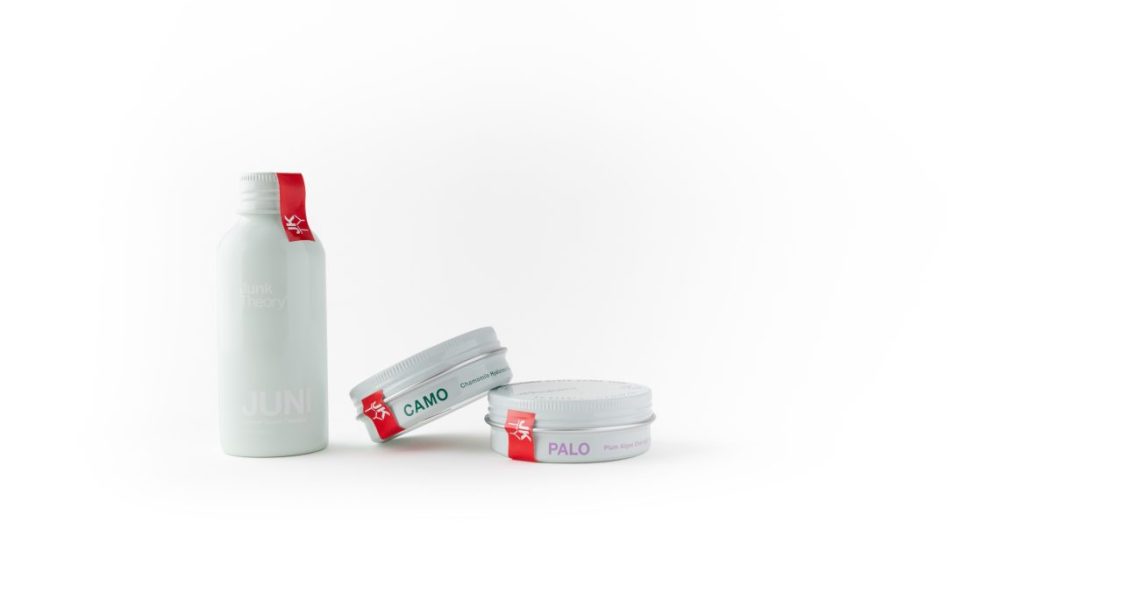When Allison Mabbott and Justin Wolff set out to create the beauty brand that became Junk Theory, their first order of business was not figuring out the Instagrammability of their packaging, but rather the sustainability. They were most concerned with the fate of the products once customers had finished them. It’s something most brands ignore, the duo said.
“Recycling systems are broken today, [especially] in the U.S.,” Mabbott said. As such, she said, it wasn’t enough for the products to be recyclable. She noted that plastic, even the better plastics — like ocean waste plastic and recycled plastic — are only recycled 5% of the time. “Ninety-five percent of the time, you put it in the recycling bin, and it’s still going to the trash.”
Junk Theory, which launched in June with three products: the $28 juniper biome cleanser, a $58 chamomile hyaluronic moisturizer and a $72 overnight moisturizing treatment. The brand is currently being sold direct-to-consumer on its own website. In the name of sustainability, the cleanser does not have a pump. “Your hands work fine,” Mabbott said. She noted that the company worked to ensure the high viscosity of the product so that it could be used without a pump, without much of the product going to waste. “A lot of” consumer testing went into the process.
The brand has some heavyweights behind it in the worlds of “clean” and “green” beauty. For example, Mia Davis, formerly Credo’s vp of sustainability and impact, is a brand advisor. It was with the help of these advisers that the founders decided there is no packaging that is better, in terms of its sustainability, than aluminum.
“This is never going to be a brand that’s going to make a million SKUs,” Wolff said, explaining that the plan is to focus on the 10 or so things consumers use in their bathrooms every single day. “If you really want to impact someone’s plastic footprint, you focus on the stuff that they’re using the most,” he said. As such, the brand is competing with brands and products that customers are already loyal to. That requires making the best possible formulas and creating the best possible product experiences, he said.
While it’s often said that the most sustainable thing is to create no new product at all, Wolff believes there is room to improve on existing beauty options. “There are things people need to buy because they need them, like toothpaste,” he said. “If toothpaste is horribly unrecyclable and unsustainable, another brand should come up with a better toothpaste.”
As for why Davis believed in the brand, she said, “It’s coming out of the gate with a meaningful commitment to sustainability; it’s ensuring that all its packaging is recyclable — and that’s truly recyclable in curbside collection programs, not theoretically recyclable, like most packaging claims in the beauty industry. They won’t launch a product if it isn’t drastically improving the status quo.”
To get the word out, the brand has not relied on paid celebrities or ambassadors. Instead, it’s seeding the products to dozens of macro- and micro-influencers. In addition, it’s working with its “Inner Circle,” a group of 100 people who sampled and helped refine the formulas as they were in development. “In the coming weeks, the program will expand. For example, [the Inner Circle will also be participating] in digital and in-person events, and [receive] first access to [new] product drops and exclusive promotions,” Wolff said.
“Through IG Live, TikToks, collabs and partnerships, we’re creating bite-size content that exposes the reality of sustainability, and educates [consumers[]on the tiny tweaks we can all do to live more junk-free,” Mabbott said. The plan is to build community — not just around beauty, but also around junk-free living — by encouraging like-minded people to get involved and learn from the brand’s social media content.




